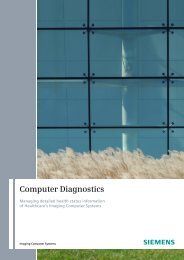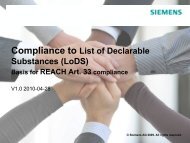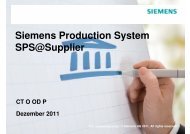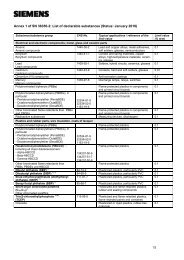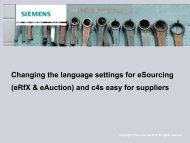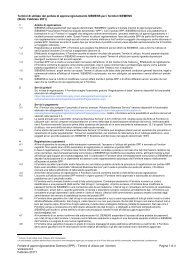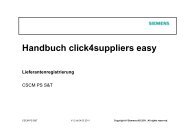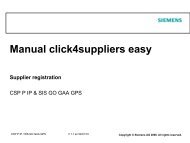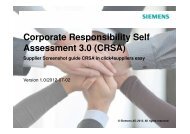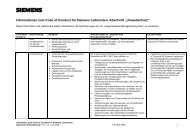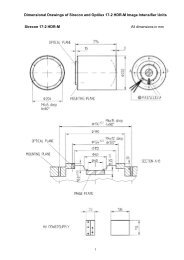Occupational Health and Safety - Siemens
Occupational Health and Safety - Siemens
Occupational Health and Safety - Siemens
Create successful ePaper yourself
Turn your PDF publications into a flip-book with our unique Google optimized e-Paper software.
Information to the Code of Conduct for <strong>Siemens</strong> Suppliers, Section ‘<strong>Occupational</strong> <strong>Health</strong> <strong>and</strong> <strong>Safety</strong>’:<br />
This information is intended to support suppliers in underst<strong>and</strong>ing the requirements of a ’reasonable management system’.<br />
The relevance of an enterprise (here the supplier) in terms of occupational health <strong>and</strong> safety is essentially dependent on the type of activities<br />
that its employees perform. A distinction is therefore made here between enterprises that perform solely administrative/management or<br />
advisory functions or purely sales- <strong>and</strong> marketing-related activities (category 1), <strong>and</strong> those that also manufacture products (systems,<br />
components, etc.) or in any other way process or rework products. It is also beneficial to assign these manufacturing enterprises to a category<br />
of SME (definition provided below). Enterprises with over 250 employees that operate in the processing or reworking industry are assigned to<br />
category 3.<br />
Microenterprises are assigned to category 1 irrespective of the industry in which they operate. In the case of these companies it is not<br />
appropriate to insist on a formalized management system. It is sufficient here for the supplier to provide evidence that it fulfills the important<br />
basic obligations that allow its employees to work safely <strong>and</strong> without accidents.<br />
Additional measures are required for category 2 enterprises, but they too are not usually expected to have a formalized management system in<br />
place.<br />
Category 3 enterprises are expected to fulfill all aspects of an occupational health <strong>and</strong> safety management system, e.g. based on OHSAS<br />
18001, <strong>and</strong> to document this fulfillment accordingly. They are currently not normally required to have the systems certified by a third party.<br />
Annex to the Code of Conduct<br />
Category Industry Minimum requirements of an "appropriate management<br />
system"<br />
1 Small <strong>and</strong> medium-sized enterprises that Provide evidence that prescribed occupational health <strong>and</strong><br />
offer or perform solely<br />
safety requirements, such as the provision of support in<br />
administrative/management, advisory or technical safety issues by specialist experts, instruction <strong>and</strong><br />
sales/marketing activities.<br />
Micro-enterprises that operate in the<br />
processing <strong>and</strong> reworking industry<br />
training for employees (including documentation) <strong>and</strong><br />
hazard assessments – are covered.<br />
2 Small <strong>and</strong> medium-sized enterprises that<br />
operate in the processing <strong>and</strong> reworking<br />
industry* )<br />
Further minimum requirements in addition to those<br />
described for category 1:<br />
Information to Code of Conduct for <strong>Siemens</strong> Suppliers<br />
Section ‘<strong>Occupational</strong> <strong>Health</strong> <strong>and</strong> <strong>Safety</strong>’, V1.0_30 July 2008 CP G AR2 1<br />
Notes<br />
Supplier signs the Code of Conduct <strong>and</strong><br />
confirms its compliance with the occupational<br />
health <strong>and</strong> safety provisions to which it is<br />
subject.<br />
In the case of category 1 companies it is not<br />
necessary for a formalized management system<br />
to be in place. It is sufficient here for the supplier<br />
to provide documentary evidence that it fulfills<br />
the important basic obligations that allow its<br />
employees to work safely <strong>and</strong> without accidents.<br />
Supplier signs the Code of Conduct <strong>and</strong><br />
confirms its compliance with the occupational<br />
health <strong>and</strong> safety provisions to which it is
Enterprises with over 250 employees that<br />
offer or perform solely<br />
administrative/management, advisory or<br />
sales/marketing activities** )<br />
3 Enterprises with over 250 employees that<br />
operate in the processing <strong>and</strong> reworking<br />
industry<br />
• Written statement of commitment to occupational health<br />
<strong>and</strong> safety by the company's management<br />
• Assessment of, <strong>and</strong> an undertaking to comply with,<br />
legal requirements<br />
• Emergency planning <strong>and</strong> hazard prevention measures<br />
Evidence of the systematic <strong>and</strong> documented implementation<br />
of the elements of an occupational health <strong>and</strong> safety<br />
management system (see below):<br />
• <strong>Occupational</strong> health <strong>and</strong> safety policy<br />
• Defined roles <strong>and</strong> responsibilities in relation to<br />
occupational health <strong>and</strong> safety<br />
• Assurance that employees <strong>and</strong> managers are qualified<br />
<strong>and</strong> trained<br />
• Records of occupational health <strong>and</strong> safety training<br />
• Hazard identification <strong>and</strong> risk assessment (hazard<br />
assessment)<br />
• Assessment of, <strong>and</strong> an undertaking to comply with,<br />
legal requirements<br />
• Established targets <strong>and</strong> programs<br />
• Definition <strong>and</strong> implemention of systems to fulfill the<br />
occupational health <strong>and</strong> safety policy <strong>and</strong> targets<br />
• Emergency planning <strong>and</strong> hazard prevention<br />
• Regular monitoring of processes, records of audits<br />
conducted regularly, assessments of the occupational<br />
health <strong>and</strong> safety management system<br />
subject, as well as the minimum requirements<br />
described for category 2, <strong>and</strong> to confirm that it<br />
will provide evidence of this compliance. A<br />
formalized management system is not<br />
necessary for category 2.<br />
The supplier may need to be classified as<br />
category 3.<br />
Supplier signs the Code of Conduct<br />
<strong>and</strong> provides evidence of an occupational health<br />
<strong>and</strong> safety management system (e.g. as defined<br />
in OHSAS 18001 or other st<strong>and</strong>ards) or it<br />
provides documentary evidence that the<br />
elements described for category 3 have been<br />
implemented.<br />
* ) In specific individual cases it may be necessary to assign category 3 status to small <strong>and</strong> medium-sized enterprises which primarily perform<br />
high-risk activities (e.g. chemical or process-engineering operations, galvanizing operations, operations involving a high degree of mechanical<br />
production). If it is unclear how a supplier is to be classified, or if <strong>Siemens</strong> takes the view that a supplier should be classified in category 3,<br />
occupational health <strong>and</strong> safety specialists must be consulted.<br />
Information to Code of Conduct for <strong>Siemens</strong> Suppliers<br />
Section ‘<strong>Occupational</strong> <strong>Health</strong> <strong>and</strong> <strong>Safety</strong>’, V1.0_30 July 2008 CP G AR2 2
** ) In specific individual cases, a classification at category 3 may be necessary (e.g. in the case of large, multinational software companies,<br />
etc.). If it is unclear how a supplier is to be classified, occupational health <strong>and</strong> safety specialists must be consulted.<br />
Notes for CSP:<br />
Category Comments<br />
1,2,3 • Audits are conducted by quality auditors on the basis of spot checks or if there are specific issues that merit investigation. CHR CP G AR2 provides audit catalogs for each of<br />
the categories; occupational health <strong>and</strong> safety specialists (e.g. work safety specialists or work safety officers) are to be consulted with any questions.<br />
Definitions/explanations:<br />
Small <strong>and</strong> medium-sized enterprises:<br />
Please refer to the EU definition of SMEs:<br />
Information to Code of Conduct for <strong>Siemens</strong> Suppliers<br />
Section ‘<strong>Occupational</strong> <strong>Health</strong> <strong>and</strong> <strong>Safety</strong>’, V1.0_30 July 2008 CP G AR2 3
Legend:<br />
New thresholds (article 2)<br />
Enterprise category Headcount: annual<br />
Turnover or Balance sheet total<br />
Medium-sized<br />
work unit (AWU)<br />





